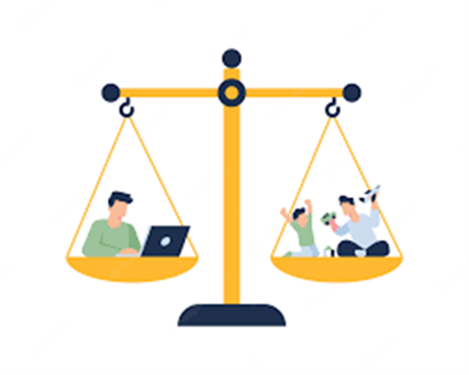We have all heard the term “work-life” balance. Why does the term start with the word “work” when we should be spending so much more time on the “life” part? This is not supposed to be a 50/50 balance. So, going forward, I plan to use the term, “life-work” balance.

What does “life-work” balance really mean? Simply put, it means maintaining a healthy balance between our work time and our personal time. It focuses on setting the appropriate boundaries so that time for non-work activities is not disrupted by work activities. Life-work balance also includes maintaining mental and physical health, as well as a stress-free work environment.
So, how can we put the “life” back into our life-work balance? Here are a few techniques we can utilize to protect our personal time and set life-work boundaries.
- First and foremost, when not at work, DON’T WORK. We are all probably guilty of setting the expectation that we will help at any time. This is partly because we are dependable and excellent team members. While in IT many of us have “after-hours” or “on-call” duties, not all after-hours matters require an immediate response. It is important to take the time to discuss expectations with your supervisor and your team.
- Make sure to set your work email, calendar, and Teams status and notifications to reflect that you are not at work.
- Another often overlooked technique is to plan ahead for time away from the office. Discuss your planned leave with your supervisor and team. Give your team time to plan with you to ensure your work is covered during your absence. This will reduce the need to interrupt your “life” time.
- Submit your leave/absences in Workday as soon as possible, and set out-of-office notifications and share your planned leave at team meetings.
- “Life-work” balance is a two-way street. When at work, avoid sending email or chats to team members after hours or if their status shows them in a meeting or focus time. You can always utilize the “delay delivery” option in Outlook to send the email on the date of their return or the next morning. Remember, email is an asynchronous tool. Do not send urgent matters via email if you need a quick response. Choose the right tool for the circumstance.
We have all felt at some point that we don’t have time to get our work assignments completed within a normal work week. Sometimes this is due to myriad meetings on our calendars or the number of competing projects/task assignments. This is an area I call “work-work” balance. Work-work balance is making sure we have adequate time to get actual work done, and protecting our time for planning and “hands-on” work. Work-work balance should also consider time for professional development, mentoring, coaching and personal productivity.
The good news is that there are great techniques to manage our work-work balance.
- We can proactively plan our work week by blocking calendar time for planning, reading and project work. You can also work with your supervisor to schedule uninterrupted time to focus on a project or professional development and training opportunities.
- Make your calendar details available and mark private appointments as private. This maintains your privacy while allowing the team to know your status. Remember, Teams pulls your current status from Outlook!
- Similar to planned leave, we should plan ahead when scheduling time for training and development to ensure our team is prepared to provide coverage.
- Regularly discuss your priorities with your supervisor. Give yourself the gift of focus by working on fewer simultaneous tasks. I find it useful to maintain a prioritized to-do list and update it each morning.
Our “life-work” and “work-work” strategies and techniques do overlap, especially as it relates to mental and physical well-being. Here are a few techniques we can utilize:

- Whether working from the office or your home office, get up from your desk periodically to stretch, doing some breathing exercises or simply take a quick walk.
- Don’t eat lunch at your desk; take a break.
- Be mindful of your work environment – is your workspace a source of stress?
- If working from home, if at all possible, dedicate a separate area of your home to be your workspace. Discuss with your family “quiet” times.
- Be mindful of how you are feeling. When primarily working from the office, we would take a sick day if not feeling well and stay home. The same should apply even if working from home. We should take the time to rest and recuperate if not feeling well.
There are some great courses in Learn@Work related to mindfulness. Here are a few that you may find helpful.
- Mindfulness Practices – Course ID: 0000019459 – 02:30 Hours – This course focuses on reducing stress and dealing with challenges both at work and at home.
- Mindfulness for Beginners – Course ID: 0000021711 – 02:24 Hours – course focuses on Mindfulness Based Stress Reduction (MBSR) to eliminate limiting perspectives and improve your awareness.
- Mindfulness at Work: The Basics – Course ID: 0000022991 – 02:35 Hours – course focuses on bringing yourself to the present by being aware of your body.
Tim Brooks
Executive Director, PPMO and Service Management Office